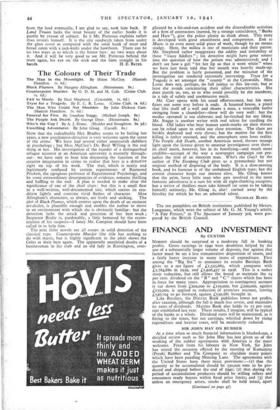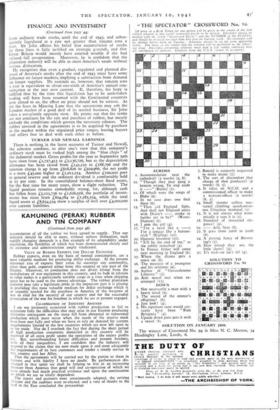FINANCE AND INVESTMENT
By CUSTOS
NOBODY should be surprised at a moderate fall in banking profits. Gross earnings in 1940 were doubtless helped by. the use of a substantially larger volume of deposits, but against-that factor must be set a less remunerative disposition of assets, and a fairly heavy increase in many items of expenditure. First among the " Big Six " to announce its results Barclays Bank gives us a net figure of £1,525,665, which compares with £1,784,880 in 5939; and £1,926,457 in 1938. This is a rather steep reduction, but still allows the board to maintain the 14 per cent. dividend on the " B " and " C " shares which has been in force for many years. Appropriation to contingency account is cut down from £200,000 to £150,000, but £200,000, against k150,000, is applied to reduction of premises account, leaving £546,704 to go forward, against £530,581 brought in.
Like Barclays, the District Bank publishes lower net profits, after taxation, although the fall is much less severe, and maintains its rates of dividends. Martins Bank also holds its 15 per cent. rate established last year. These results, I imagine, will be typical of the banks as a whole. Dividend rates will be maintained, as is fitting to the times, but net earnings, whittled down by rising expenditure and heavier taxes, will be moderately reduced.
SIR JOHN HAY ON RUBBER
At a time when so much financial information is blacked-out, a detailed review such as Sir John Hay has just given us of the working of the rubber agreements with America is the more welcome. Fresh from his labours in New York, Sir John has seized the occasion offered by the meeting of Kamuning (Perak) Rubber and Tin Company to elucidate many -points which have been puzzling Mincing Lane. The agreements with the United States have three main provisions :—(/) that the quantity to be accumulated should be 330,000 tons to be pro- duced and shipped before the end of 194s; (2) that. during the period of accumulation producers should be willing sellers and consumers ready buyers within fixed price limits; and (3) that unless an emergency arises, stocks shall be held intact, apart (Continued on page 47)
FINANCE AND INVESTMENT
(Continued from page 44) from ordinary trade stocks, until the end of 1943, and subse- quently liquidated at a rate not greater than too,000 tons a year. ear Sir John affirms his belief that accumulation of stocks on these lines is fully justified on strategic grounds, and that Great Britain would merely have courted trouble if she had refused full co-operation. Moreover, he is confident that the plantation industry will be able to meet America's needs without serious dislocation.
He recognises that even a gradual, regulated and planned dis- posal of America's stocks after the end of 1943 must have some influence on future markets, implying a subtraction from demand on future supplies. He reminds us, however, that ioo,000 tons a year is equivalent to about one-sixth of America's annual con- sumption at the rate now current. If, therefore, his hope is fulfilled that by the time this liquidation has to be undertaken trading will have been resumed with the Continental countries now closed to us, the effect on price should not be serious. As for the fears in Mincing Lane that the agreements may rob the London market of a good deal of its normal business, Sir John takes a completely opposite view. He points out that the terms are not contracts for the sale and purchase of rubber, but merely embody the conditions which govern the necessary releases. The rubber covered in the agreements is to be acquired by purchase in the market within the stipulated price ranges, leaving buyers and sellers free to deal with each other as before..
TURNER AND NEWALL EARNINGS
There is nothing in the latest accounts of Turner and Newall, the asbestos combine, to alter one's view that this company's ordinary stock must be ranked high among the " blue chips " of the industrial market. Gross profits for the year to September 30th have risen from £1,727,453 to £2,136,726, but as the depreciation allowance has been raised from £145,250 to £188,796 and the taxation charge is up from £618,826 to £929,966, the net profit is a mere £45,000 higher at £1,015,214. Another Lioo,000 goes to general reserve and the ordinary dividend is comfortably held at 15 per cent. In the consolidated balance-sheet fixed assets, for the first time for many years, show a slight reduction. The liquid position remains remarkably strong, for, although cash has fallen from £2,125,736 to £1,626,028, the portfolio of invest- ments has risen from £804,584 to £1,585,334, while the total liquid assets at £8,654,524 show a surplus of well over £4,000,000 over current liabilities.



























 Previous page
Previous page